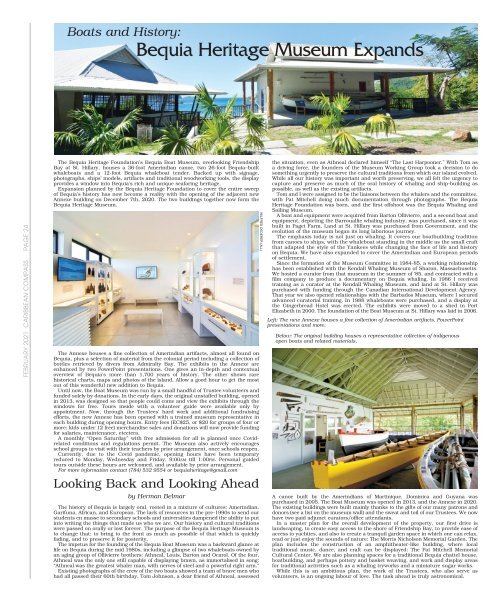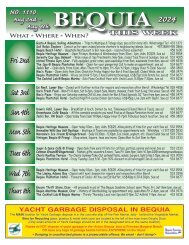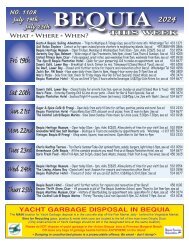Caribbean Compass Yachting Magazine - February 2021
Welcome to Caribbean Compass, the most widely-read boating publication in the Caribbean! THE MOST NEWS YOU CAN USE - feature articles on cruising destinations, regattas, environment, events...
Welcome to Caribbean Compass, the most widely-read boating publication in the Caribbean! THE MOST NEWS YOU CAN USE - feature articles on cruising destinations, regattas, environment, events...
Create successful ePaper yourself
Turn your PDF publications into a flip-book with our unique Google optimized e-Paper software.
Boats and History:<br />
Bequia Heritage Museum Expands<br />
FEBRUARY <strong>2021</strong> CARIBBEAN COMPASS PAGE 24<br />
The Bequia Heritage Foundation’s Bequia Boat Museum, overlooking Friendship<br />
Bay at St. Hillary, houses a 36-foot Amerindian canoe, two 26-foot Bequia–built<br />
whaleboats and a 12-foot Bequia whaleboat tender. Backed up with signage,<br />
photographs, ships’ models, artifacts and traditional woodworking tools, the display<br />
provides a window into Bequia’s rich and unique seafaring heritage.<br />
Expansion planned by the Bequia Heritage Foundation to cover the entire sweep<br />
of Bequia’s history has now become a reality with the opening of the adjacent new<br />
Annexe building on December 7th, 2020. The two buildings together now form the<br />
Bequia Heritage Museum.<br />
The Annexe houses a fine collection of Amerindian artifacts, almost all found on<br />
Bequia, plus a selection of material from the colonial period including a collection of<br />
bottles retrieved by divers from Admiralty Bay. The exhibits in the Annexe are<br />
enhanced by two PowerPoint presentations. One gives an in-depth and contextual<br />
overview of Bequia’s more than 1,700 years of history. The other shows rare<br />
historical charts, maps and photos of the island. Allow a good hour to get the most<br />
out of this wonderful new addition to Bequia.<br />
Until now, the Boat Museum was run by a small handful of Trustee volunteers and<br />
funded solely by donations. In the early days, the original unstaffed building, opened<br />
in 2013, was designed so that people could come and view the exhibits through the<br />
windows for free. Tours inside with a volunteer guide were available only by<br />
appointment. Now, through the Trustees’ hard work and additional fundraising<br />
efforts, the new Annexe has been opened with a trained museum representative in<br />
each building during opening hours. Entry fees (EC$25, or $20 for groups of four or<br />
more; kids under 12 free) merchandise sales and donations will now provide funding<br />
for salaries, maintenance, etcetera.<br />
A monthly “Open Saturday” with free admission for all is planned once Covidrelated<br />
conditions and regulations permit. The Museum also actively encourages<br />
school groups to visit with their teachers by prior arrangement, once schools reopen.<br />
Currently, due to the Covid pandemic, opening hours have been temporary<br />
reduced to Monday, Wednesday and Friday, 9:00am till 1:00pm. Personal guided<br />
tours outside these hours are welcomed, and available by prior arrangement.<br />
For more information contact (784) 532 9554 or bequiaheritage@gmail.com<br />
Looking Back and Looking Ahead<br />
by Herman Belmar<br />
The history of Bequia is largely oral, rooted in a mixture of cultures: Amerindian,<br />
Garifuna, African, and European. The lack of resources in the pre-1990s to send our<br />
students en masse to secondary schools and universities dampened the ability to put<br />
into writing the things that made us who we are. Our history and cultural traditions<br />
were passed on orally or lost forever. The purpose of the Bequia Heritage Museum is<br />
to change that: to bring to the front as much as possible of that which is quickly<br />
fading, and to preserve it for posterity.<br />
The impetus for the founding of the Bequia Boat Museum was a backward glance at<br />
life on Bequia during the mid 1980s, including a glimpse of two whaleboats owned by<br />
an aging group of Ollivierre brothers: Athneal, Louis, Barton and Ocarol. Of the four,<br />
Athneal was the only one still capable of displaying brawn, as immortalised in song:<br />
“Athneal was the greatest whaler man, with nerves of steel and a powerful right arm.”<br />
Existing photographs of the crew of the two boats showed a team of brave men who<br />
had all passed their 60th birthday. Tom Johnson, a dear friend of Athneal, assessed<br />
WILFRED DEDERER (ALL)<br />
the situation, even as Athneal declared himself “The Last Harpooner.” With Tom as<br />
a driving force, the founders of the Museum Working Group took a decision to do<br />
something urgently to preserve the cultural traditions from which our island evolved.<br />
While all our history was important and worth preserving, we all felt the urgency to<br />
capture and preserve as much of the oral history of whaling and ship-building as<br />
possible, as well as the existing artifacts.<br />
Tom and I were assigned to be the liaisons between the whalers and the committee,<br />
with Pat Mitchell doing much documentation through photographs. The Bequia<br />
Heritage Foundation was born, and the first offshoot was the Bequia Whaling and<br />
Sailing Museum.<br />
A boat and equipment were acquired from Barton Ollivierre, and a second boat and<br />
equipment, depicting the Barrouallie whaling industry, was purchased, since it was<br />
built in Paget Farm. Land at St. Hillary was purchased from Government, and the<br />
evolution of the museum began its long laborious journey.<br />
The emphasis today is not just on whaling. It covers our boatbuilding tradition<br />
from canoes to ships, with the whaleboat standing in the middle as the small craft<br />
that adapted the style of the Yankees while changing the face of life and history<br />
on Bequia. We have also expanded to cover the Amerindian and European periods<br />
of settlement.<br />
Since the formation of the Museum Committee in 1984-85, a working relationship<br />
has been established with the Kendall Whaling Museum of Sharon, Massachusetts.<br />
We hosted a curator from that museum in the summer of ’85, and contracted with a<br />
film company to produce a documentary on Bequia whaling. In 1986 I received<br />
training as a curator at the Kendall Whaling Museum, and land at St. Hillary was<br />
purchased with funding through the Canadian International Development Agency.<br />
That year we also opened relationships with the Barbados Museum, where I secured<br />
advanced curatorial training. In 1988 whaleboats were purchased, and a display at<br />
the Gingerbread Hotel was erected. The exhibits were moved to a shed in Port<br />
Elizabeth in 2000. The foundation of the Boat Museum at St. Hillary was laid in 2006.<br />
Left: The new Annexe houses a fine collection of Amerindian artifacts, PowerPoint<br />
presentations and more.<br />
Below: The original building houses a representative collection of indigenous<br />
open boats and related materials.<br />
A canoe built by the Amerindians of Martinique, Dominica and Guyana was<br />
purchased in 2005. The Boat Museum was opened in 2013, and the Annexe in 2020.<br />
The existing buildings were built mainly thanks to the gifts of our many patrons and<br />
donors (see a list on the museum wall) and the sweat and toil of our Trustees. We now<br />
have two paid adjunct curators/office attendants.<br />
In a master plan for the overall development of the property, our first drive is<br />
landscaping, to create easy access to the shore of Friendship Bay, to provide ease of<br />
access to yachties, and also to create a tranquil garden space in which one can relax,<br />
read or just enjoy the sounds of nature: The Morris Nicholson Memorial Garden. The<br />
plan includes the construction of an amphitheater-like building, where local<br />
traditional music, dance, and craft can be displayed: The Pat Mitchell Memorial<br />
Cultural Center. We are also planning spaces for a traditional Bequia chattel house,<br />
boatbuilding, and perhaps pottery and basket weaving, and work and display areas<br />
for traditional activities such as a whaling tryworks and a miniature sugar works.<br />
While this is an ambitious plan, the work of the Trustees, who also serve as<br />
volunteers, is an ongoing labour of love. The task ahead is truly astronomical.

















